参考文献:
https://www.cnblogs.com/mchina/archive/2013/02/20/2883404.html
https://www.jianshu.com/p/3476d98a4703
软件介绍与原理我是直接copy的第一篇文献的,因为里面介绍的很清楚,我就未作修改。感谢。
什么是nagios
Nagios是一款开源的电脑系统和网络监视工具,能有效监控Windows、Linux和Unix的主机状态,交换机路由器等网络设置,打印机等。在系统或服务状态异常时发出邮件或短信报警第一时间通知网站运维人员,在状态恢复后发出正常的邮件或短信通知。
Nagios被开发在Linux下使用,但在Unix下也工作得非常好。
主要功能
网络服务监控(SMTP、POP3、HTTP、NNTP、ICMP、SNMP、FTP、SSH)
主机资源监控(CPU load、disk usage、system logs),也包括Windows主机(使用NSClient++ plugin)
可以指定自己编写的Plugin通过网络收集数据来监控任何情况(温度、警告……)
可以通过配置Nagios远程执行插件远程执行脚本
远程监控支持SSH或SSL加通道方式进行监控
简单的plugin设计允许用户很容易的开发自己需要的检查服务,支持很多开发语言(shell scripts、C++、Perl、ruby、Python、PHP、C#等)
包含很多图形化数据Plugins(Nagiosgraph、Nagiosgrapher、PNP4Nagios等)
可并行服务检查
能够定义网络主机的层次,允许逐级检查,就是从父主机开始向下检查
当服务或主机出现问题时发出通告,可通过email, pager, sms 或任意用户自定义的plugin进行通知
能够自定义事件处理机制重新激活出问题的服务或主机
自动日志循环
支持冗余监控
包括Web界面可以查看当前网络状态,通知,问题历史,日志文件等
工作原理
Nagios的功能是监控服务和主机,但是他自身并不包括这部分功能,所有的监控、检测功能都是通过各种插件来完成的。
启动Nagios后,它会周期性的自动调用插件去检测服务器状态,同时Nagios会维持一个队列,所有插件返回来的状态信息都进入队列,Nagios每次都从队首开始读取信息,并进行处理后,把状态结果通过web显示出来。
Nagios提供了许多插件,利用这些插件可以方便的监控很多服务状态。安装完成后,在nagios主目录下的/libexec里放有nagios自带的可以使用的所有插件,如,check_disk是检查磁盘空间的插件,check_load是检查CPU负载的,等等。每一个插件可以通过运行./check_xxx –h 来查看其使用方法和功能。
Nagios可以识别4种状态返回信息,即 0(OK)表示状态正常/绿色、1(WARNING)表示出现警告/黄色、2(CRITICAL)表示出现非常严重的错误/红色、3(UNKNOWN)表示未知错误/深黄色。Nagios根据插件返回来的值,来判断监控对象的状态,并通过web显示出来,以供管理员及时发现故障。
Nagios 自身也没有报警部分的代码,甚至没有插件,而是交给用户或者其他相关开源项目组去完成的。
Nagios 安装,是指基本平台,也就是Nagios软件包的安装。它是监控体系的框架,也是所有监控的基础。
打开Nagios官方的文档,会发现Nagios基本上没有什么依赖包,只要求系统是Linux或者其他Nagios支持的系统。不过如果你没有安装apache(http服务),那么你就没有那么直观的界面来查看监控信息了,所以apache姑且算是一个前提条件。关于apache的安装,网上有很多,照着安装就是了。安装之后要检查一下是否可以正常工作。
知道Nagios 是如何通过插件来管理服务器对象后,现在开始研究它是如何管理远端服务器对象的。Nagios 系统提供了一个插件NRPE。Nagios 通过周期性的运行它来获得远端服务器的各种状态信息。它们之间的关系如下图所示:
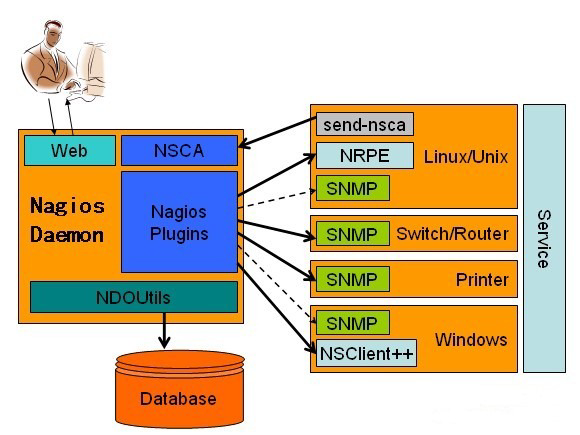
Nagios 通过NRPE 来远端管理服务
-
Nagios 执行安装在它里面的check_nrpe 插件,并告诉check_nrpe 去检测哪些服务。
-
通过SSL,check_nrpe 连接远端机子上的NRPE daemon
-
NRPE 运行本地的各种插件去检测本地的服务和状态(check_disk,..etc)
-
最后,NRPE 把检测的结果传给主机端的check_nrpe,check_nrpe 再把结果送到Nagios状态队列中。
-
Nagios 依次读取队列中的信息,再把结果显示出来。
实验环境
【 nagios-server 】 centos 7.5 10.2.8.69 Apache、Php、Nagios、nagios-plugins、nrpe
【 nagios-agent 】 centos 7.5 10.2.8.70 nagios-plugins、nrpe
server 安装了nagios软件,对监控的数据做处理,并且提供web界面查看和管理。当然也可以对本机自身的信息进行监控。
agent 安装了NRPE等客户端,根据监控机的请求执行监控,然后将结果回传给监控机。
软件版本
Apache httpd-2.2.23.tar.gz
php php-5.6.39.tar.gz
nagios nagios-4.3.1.tar.gz
nagios-plugins nagios-plugins-2.1.4
nrpe nrpe-3.1.0.tar.gz
nagios-server安装部署
本次安装为非root用户,故很多命令需要sudo的方式来执行
准备工作
关闭防火墙,SELINUX=disabled
下载yum源
sudo wget http://mirrors.aliyun.com/repo/Centos-7.repo
sudo wget http://mirrors.aliyun.com/repo/epel-7.repo
下载软件包
cd ~
wget https://sourceforge.net/projects/nagios/files/nrpe-3.x/nrpe-3.1.0.tar.gz
wget https://assets.nagios.com/downloads/nagioscore/releases/nagios-4.3.1.tar.gz
wget https://nagios-plugins.org/download/nagios-plugins-2.1.4.tar.gz
wget http://cn2.php.net/distributions/php-5.6.39.tar.gz
wget http://archive.apache.org/dist/httpd/httpd-2.2.23.tar.gz
yum安装一些套件与依赖包
sudo yum install -y gcc glibc glibc-common gd gd-devel xinetd libxml2 libxml2-devel bzip2 bzip2-devel curl curl-devel php-mcrypt libmcrypt libmcrypt-devel *openssl*
添加用户
useradd -s /sbin/nologin nagios
mkdir /usr/local/nagios
sudo chown nagios. /usr/local/nagios
安装nagios
tar -xvf nagios-4.3.1.tar.gz
cd nagios-4.3.1
./configure --prefix=/usr/local/nagios
sudo make all
sudo make install
#出现 make[1]: Leaving directory `/home/xxx/nagios-4.3.1' 不用管
sudo make install-init
sudo make install-commandmode
sudo make install-config
将nagios添加为系统服务,设置其在级别3与5时为开机运行服务,显示指定的服务在不同运行级的状态信息(on/off)
sudo chkconfig --add nagios
sudo chkconfig --level 35 nagios on
sudo chkconfig --list nagios
安装nagios-plugin
tar -xvf nagios-plugins-2.1.4.tar.gz
cd nagios-plugins-2.1.4
./configure --prefix=/usr/local/nagios
sudo make
sudo make install
在make与make install 时,出现以下行为正常现象,不用管
make[2]: Leaving directory `/home/xx/nagios-plugins-2.1.4/plugins-root'
Making all in po
make[2]: Entering directory `/home/xx/nagios-plugins-2.1.4/po'
make[2]: Nothing to be done for `all'.
make[2]: Leaving directory `/home/xx/nagios-plugins-2.1.4/po'
make[2]: Entering directory `/home/xx/nagios-plugins-2.1.4'
make[2]: Leaving directory `/home/xx/nagios-plugins-2.1.4'
make[1]: Leaving directory `/home/xx/nagios-plugins-2.1.4
安装apache
tar -xvf httpd-2.2.23.tar.gz
cd httpd-2.2.23
./configure --prefix=/usr/local/apache
sudo make
sudo make install
在make与make install出现以下行,不用管
make[1]: Leaving directory `/home/xx/httpd-2.2.23'
安装php
tar -xvf php-5.6.39.tar.gz
cd php-5.6.39
./configure --prefix=/usr/local/php --with-apxs2=/usr/local/apache/bin/apxs
sudo make
sudo make install
配置nagios用户授权
sudo vim /usr/local/apache/conf/httpd.conf
User daemon
Group daemon
改为
User nagios
Group nagios
#ServerName www.example.com:80
改为
ServerName 127.0.0.1:80
<IfModule dir_module>
DirectoryIndex index.html
</IfModule>
改为
<IfModule dir_module>
DirectoryIndex index.html index.php
AddType application/x-httpd-php .php
</IfModule>
在 /usr/local/apache/conf/httpd.conf最后添加
#setting for nagios
ScriptAlias /nagios/cgi-bin "/usr/local/nagios/sbin"
<Directory "/usr/local/nagios/sbin">
AuthType Basic
Options ExecCGI
AllowOverride None
Order allow,deny
Allow from all
AuthName "Nagios Access"
AuthUserFile /usr/local/nagios/etc/htpasswd //用于此目录访问身份验证的文件
Require valid-user
</Directory>
Alias /nagios "/usr/local/nagios/share"
<Directory "/usr/local/nagios/share">
AuthType Basic
Options None
AllowOverride None
Order allow,deny
Allow from all
AuthName "nagios Access"
AuthUserFile /usr/local/nagios/etc/htpasswd
Require valid-user
</Directory>
创建登陆nagios的web页面的验证文件
sudo /usr/local/apache/bin/htpasswd -c /usr/local/nagios/etc/htpasswd yangh
登陆nagios主页面
起服务
cd /usr/local/apache/bin/
sudo ./apachectl start
sudo systemctl start nagios
页面访问:http://ip:80/nagios
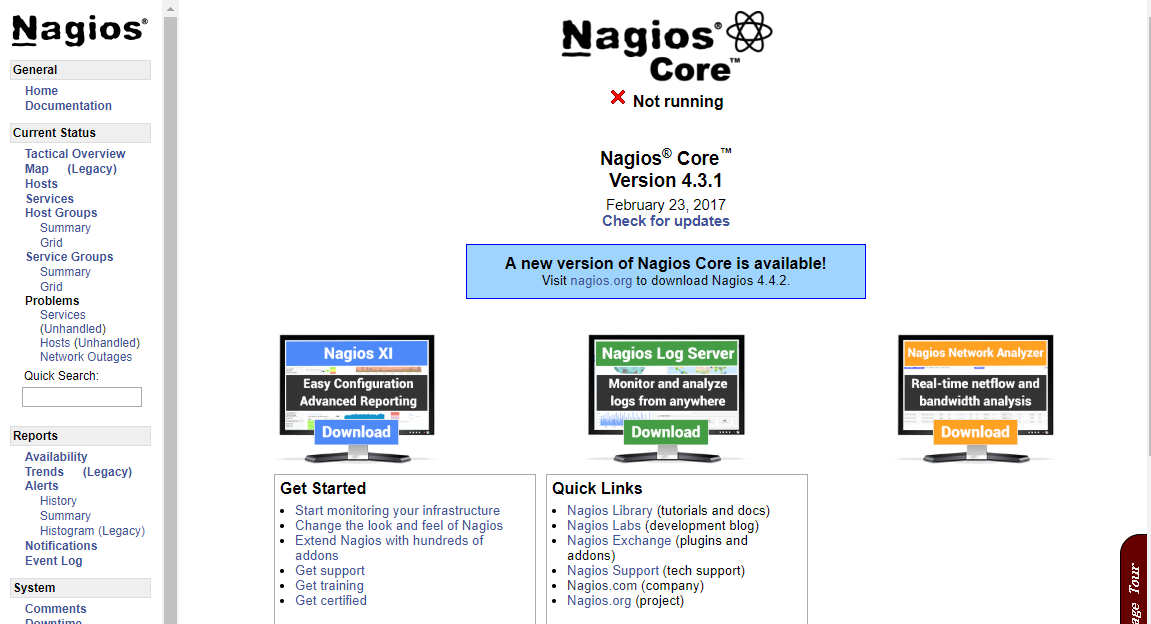
nagios监控配置
nagios对各种资源对象,状态监控以及报警策略等都通过配置文件定义,nagios仅提供一些模板文件。
默认配置文件介绍
Nagios 安装完毕后,默认的配置文件在/usr/local/nagios/etc目录下,每个配置文件的说明如下:
文件名或目录名 用途
cgi.cfg 控制CGI访问的配置文件
nagios.cfg Nagios 主配置文件
resource.cfg 变量定义文件,又称为资源文件,在些文件中定义变量,以便由其他配置文件引用,如$USER1$
objects objects 是一个目录,在此目录下有很多配置文件模板,用于定义Nagios 对象
objects/commands.cfg 命令定义配置文件,其中定义的命令可以被其他配置文件引用
objects/contacts.cfg 定义联系人和联系人组的配置文件
objects/localhost.cfg 定义监控本地主机的配置文件
objects/printer.cfg 定义监控打印机的一个配置文件模板,默认没有启用此文件
objects/switch.cfg 定义监控路由器的一个配置文件模板,默认没有启用此文件
objects/templates.cfg 定义主机和服务的一个模板配置文件,可以在其他配置文件中引用
objects/timeperiods.cfg 定义Nagios 监控时间段的配置文件
objects/windows.cfg 监控Windows 主机的一个配置文件模板,默认没有启用此文件
配置文件之间的关系
在nagios的配置过程中涉及到的几个定义有:主机、主机组,服务、服务组,联系人、联系人组,监控时间,监控命令等,从这些定义可以看出,nagios各个配置文件之间是互为关联,彼此引用的。
成功配置出一台nagios监控系统,必须要弄清楚每个配置文件之间依赖与被依赖的关系,最重要的有四点:
第一:定义监控哪些主机、主机组、服务和服务组;
第二:定义这个监控要用什么命令实现;
第三:定义监控的时间段;
第四:定义主机或服务出现问题时要通知的联系人和联系人组。
配置
为了能更清楚的说明问题,同时也为了维护方便,建议将nagios各个定义对象创建独立的配置文件:
创建hosts.cfg文件来定义主机和主机组
创建services.cfg文件来定义服务
用默认的contacts.cfg文件来定义联系人和联系人组
用默认的commands.cfg文件来定义命令
用默认的timeperiods.cfg来定义监控时间段
用默认的templates.cfg文件作为资源引用文件
templates.cfg文件
nagios的监控主机资源以及服务,在nagios配置中称为对象,为了不必重复定义一些监控对象,Nagios引入了一个模板配置文件,将一些共性的属性定义成模板,以便于多次引用。这就是templates.cfg的作用。
配置详解
define contact{
name generic-contact ; 联系人名称
service_notification_period 24x7 ; 当服务出现异常时,发送通知的时间段,这个时间段"24x7"在timeperiods.cfg文件中定义
host_notification_period 24x7 ; 当主机出现异常时,发送通知的时间段,这个时间段"24x7"在timeperiods.cfg文件中定义
service_notification_options w,u,c,r ; 这个定义的是“通知可以被发出的情况”。w即warn,表示警告状态,u即unknown,表示不明状态;
; c即criticle,表示紧急状态,r即recover,表示恢复状态;
; 也就是在服务出现警告状态、未知状态、紧急状态和重新恢复状态时都发送通知给使用者。
host_notification_options d,u,r ; 定义主机在什么状态下需要发送通知给使用者,d即down,表示宕机状态;
; u即unreachable,表示不可到达状态,r即recovery,表示重新恢复状态。
service_notification_commands notify-service-by-email ; 服务故障时,发送通知的方式,可以是邮件和短信,这里发送的方式是邮件;
; 其中“notify-service-by-email”在commands.cfg文件中定义。
host_notification_commands notify-host-by-email ; 主机故障时,发送通知的方式,可以是邮件和短信,这里发送的方式是>邮件;
; 其中“notify-host-by-email”在commands.cfg文件中定义。
register 0 ; DONT REGISTER THIS DEFINITION - ITS NOT A REAL CONTACT, JUST A TEMPLATE!
}
define host{
name generic-host ; 主机名称,这里的主机名,并不是直接对应到真正机器的主机名;
; 乃是对应到在主机配置文件里所设定的主机名。
notifications_enabled 1 ; Host notifications are enabled
event_handler_enabled 1 ; Host event handler is enabled
flap_detection_enabled 1 ; Flap detection is enabled
failure_prediction_enabled 1 ; Failure prediction is enabled
process_perf_data 1 ; 其值可以为0或1,其作用为是否启用Nagios的数据输出功能;
; 如果将此项赋值为1,那么Nagios就会将收集的数据写入某个文件中,以备提取。
retain_status_information 1 ; Retain status information across program restarts
retain_nonstatus_information 1 ; Retain non-status information across program restarts
notification_period 24x7 ; 指定“发送通知”的时间段,也就是可以在什么时候发送通知给使用者。
register 0 ; DONT REGISTER THIS DEFINITION - ITS NOT A REAL HOST, JUST A TEMPLATE!
}
define host{
name linux-server ; 主机名称
use generic-host ; use表示引用,也就是将主机generic-host的所有属性引用到linux-server中来;
; 在nagios配置中,很多情况下会用到引用。
check_period 24x7 ; 这里的check_period告诉nagios检查主机的时间段
check_interval 5 ; nagios对主机的检查时间间隔,这里是5分钟。
retry_interval 1 ; 重试检查时间间隔,单位是分钟。
max_check_attempts 10 ; nagios对主机的最大检查次数,也就是nagios在检查发现某主机异常时,并不马上判断为异常状况;
; 而是多试几次,因为有可能只是一时网络太拥挤,或是一些其他原因,让主机受到了一点影响;
; 这里的10就是最多试10次的意思。
check_command check-host-alive ; 指定检查主机状态的命令,其中“check-host-alive”在commands.cfg文件中定义。
notification_period 24x7 ; 主机故障时,发送通知的时间范围,其中“workhours”在timeperiods.cfg中进行了定义;
; 下面会陆续讲到。
notification_interval 10 ; 在主机出现异常后,故障一直没有解决,nagios再次对使用者发出通知的时间。单位是分钟;
; 如果你觉得,所有的事件只需要一次通知就够了,可以把这里的选项设为0
notification_options d,u,r ; 定义主机在什么状态下可以发送通知给使用者,d即down,表示宕机状态;
; u即unreachable,表示不可到达状态;
; r即recovery,表示重新恢复状态。
contact_groups test ; 指定联系人组,这个“admins”在contacts.cfg文件中定义。
register 0 ; DONT REGISTER THIS DEFINITION - ITS NOT A REAL HOST, JUST A TEMPLATE!
}
define host{
name windows-server ; The name of this host template
use generic-host ; Inherit default values from the generic-host template
check_period 24x7 ; By default, Windows servers are monitored round the clock
check_interval 5 ; Actively check the server every 5 minutes
retry_interval 1 ; Schedule host check retries at 1 minute intervals
max_check_attempts 10 ; Check each server 10 times (max)
check_command check-host-alive ; Default command to check if servers are "alive"
notification_period 24x7 ; Send notification out at any time - day or night
notification_interval 10 ; Resend notifications every 30 minutes
notification_options d,r ; Only send notifications for specific host states
contact_groups test ; Notifications get sent to the admins by default
hostgroups windows-servers ; Host groups that Windows servers should be a member of
register 0 ; DONT REGISTER THIS - ITS JUST A TEMPLATE
}
define service{
name generic-service ; 定义一个服务名称
active_checks_enabled 1 ; Active service checks are enabled
passive_checks_enabled 1 ; Passive service checks are enabled/accepted
parallelize_check 1 ; Active service checks should be parallelized;
; (disabling this can lead to major performance problems)
obsess_over_service 1 ; We should obsess over this service (if necessary)
check_freshness 0 ; Default is to NOT check service 'freshness'
notifications_enabled 1 ; Service notifications are enabled
event_handler_enabled 1 ; Service event handler is enabled
flap_detection_enabled 1 ; Flap detection is enabled
failure_prediction_enabled 1 ; Failure prediction is enabled
process_perf_data 1 ; Process performance data
retain_status_information 1 ; Retain status information across program restarts
retain_nonstatus_information 1 ; Retain non-status information across program restarts
is_volatile 0 ; The service is not volatile
check_period 24x7 ; 这里的check_period告诉nagios检查服务的时间段。
max_check_attempts 3 ; nagios对服务的最大检查次数。
normal_check_interval 5 ; 此选项是用来设置服务检查时间间隔,也就是说,nagios这一次检查和下一次检查之间所隔的时间;
; 这里是5分钟。
retry_check_interval 2 ; 重试检查时间间隔,单位是分钟。
contact_groups test ; 指定联系人组
notification_options w,u,c,r ; 这个定义的是“通知可以被发出的情况”。w即warn,表示警告状态;
; u即unknown,表示不明状态;
; c即criticle,表示紧急状态,r即recover,表示恢复状态;
; 也就是在服务出现警告状态、未知状态、紧急状态和重新恢复后都发送通知给使用者。
notification_interval 10 ; Re-notify about service problems every hour
notification_period 24x7 ; 指定“发送通知”的时间段,也就是可以在什么时候发送通知给使用者。
register 0 ; DONT REGISTER THIS DEFINITION - ITS NOT A REAL SERVICE, JUST A TEMPLATE!
}
define service{
name local-service ; The name of this service template
use generic-service ; Inherit default values from the generic-service definition
max_check_attempts 4 ; Re-check the service up to 4 times in order to determine its final (hard) state
normal_check_interval 5 ; Check the service every 5 minutes under normal conditions
retry_check_interval 1 ; Re-check the service every minute until a hard state can be determined
register 0 ; DONT REGISTER THIS DEFINITION - ITS NOT A REAL SERVICE, JUST A TEMPLATE!
}
resource.cfg 文件
resource.cfg是nagios的变量定义文件,文件内容只有一行:
$USER1$=/usr/local/nagios/libexec
其中,变量$USER1$指定了安装nagios插件的路径,如果把插件安装在了其它路径,只需在这里进行修改即可。需要注意的是,变量必须先定义,然后才能在其它配置文件中进行引用。
commands.cfg文件
此文件默认是存在的,无需修改即可使用,当然如果有新的命令需要加入时,在此文件进行添加即可。
#notify-host-by-email命令的定义
define command{
command_name notify-host-by-email #命令名称,即定义了一个主机异常时发送邮件的命令。
command_line /usr/bin/printf "%b" "***** Nagios *****
Notification Type: $NOTIFICATIONTYPE$
Host: $HOSTNAME$
State: $HOSTSTATE$
Address: $HOSTADDRESS$
Info: $HOSTOUTPUT$
Date/Time: $LONGDATETIME$
" | /bin/mail -s "** $NOTIFICATIONTYPE$ Host Alert: $HOSTNAME$ is $HOSTSTATE$ **" $CONTACTEMAIL$ #命令具体的执行方式。
}
#notify-service-by-email命令的定义
define command{
command_name notify-service-by-email #命令名称,即定义了一个服务异常时发送邮件的命令
command_line /usr/bin/printf "%b" "***** Nagios *****
Notification Type: $NOTIFICATIONTYPE$
Service: $SERVICEDESC$
Host: $HOSTALIAS$
Address: $HOSTADDRESS$
State: $SERVICESTATE$
Date/Time: $LONGDATETIME$
Additional Info:
$SERVICEOUTPUT$
" | /bin/mail -s "** $NOTIFICATIONTYPE$ Service Alert: $HOSTALIAS$/$SERVICEDESC$ is $SERVICESTATE$ **" $CONTACTEMAIL$
}
#check-host-alive命令的定义
define command{
command_name check-host-alive #命令名称,用来检测主机状态。
command_line $USER1$/check_ping -H $HOSTADDRESS$ -w 3000.0,80% -c 5000.0,100% -p 5
# 这里的变量$USER1$在resource.cfg文件中进行定义,即$USER1$=/usr/local/nagios/libexec;
# 那么check_ping的完整路径为/usr/local/nagios/libexec/check_ping;
# “-w 3000.0,80%” 3000ms响应时间内,丢包率超过80%,报警级别为warning。
# “-c 5000.0,100%” 5000ms响应时间内,丢包率为100%,报警级别为critical。
# “-p 1”说明每次探测发送一个包。
}
define command{
command_name check_local_disk
command_line $USER1$/check_disk -w $ARG1$ -c $ARG2$ -p $ARG3$ #$ARG1$是指在调用这个命令的时候,命令后面的第一个参数。
}
define command{
command_name check_local_load
command_line $USER1$/check_load -w $ARG1$ -c $ARG2$
}
define command{
command_name check_local_procs
command_line $USER1$/check_procs -w $ARG1$ -c $ARG2$ -s $ARG3$
}
define command{
command_name check_local_users
command_line $USER1$/check_users -w $ARG1$ -c $ARG2$
}
define command{
command_name check_local_swap
command_line $USER1$/check_swap -w $ARG1$ -c $ARG2$
}
define command{
command_name check_ftp
command_line $USER1$/check_ftp -H $HOSTADDRESS$ $ARG1$
}
define command{
command_name check_http
command_line $USER1$/check_http -I $HOSTADDRESS$ $ARG1$
}
define command{
command_name check_ssh
command_line $USER1$/check_ssh $ARG1$ $HOSTADDRESS$
}
define command{
command_name check_ping
command_line $USER1$/check_ping -H $HOSTADDRESS$ -w $ARG1$ -c $ARG2$ -p 5
}
define command{
command_name check_nt
command_line $USER1$/check_nt -H $HOSTADDRESS$ -p 12489 -v $ARG1$ $ARG2$
}
hosts.cfg文件
此文件默认不存在,需要手动创建,hosts.cfg主要用来指定被监控的主机地址以及相关属性信息,根据实验目标配置如下:
define host{
use linux-server ;引用主机linux-server的属性信息,linux-server主机在templates.cfg文件中进行了定义。
host_name nagios-agent ;主机名
alias nagios-agent ;主机别名
address 10.2.8.70 ;被监控的主机地址,这个地址可以是ip,也可以是域名。
}
;定义一个主机组
define hostgroup{
hostgroup_name bsmart-servers ;主机组名称,可以随意指定。
alias bsmart servers ;主机组别名
members nagios-agent ;主机组成员,其中“nagios-agent”就是上面定义的主机。
}
在/usr/local/nagios/etc/objects 下默认有localhost.cfg 和windows.cfg 这两个配置文件,localhost.cfg 文件是定义监控主机本身的,windows.cfg 文件是定义windows 主机的,其中包括了对host 和相关services 的定义。所以在本次实验中,将直接在localhost.cfg 中定义监控主机(Nagios-Server),在windows.cfg中定义windows 主机(Nagios-Windows)。根据自己的需要修改其中的相关配置,详细如下:
localhost.cfg文件
define host{
use linux-server ; Name of host template to use
; This host definition will inherit all variables that are defined
; in (or inherited by) the linux-server host template definition.
host_name nagios-server
alias nagios-server
address 127.0.0.1
}
define hostgroup{
hostgroup_name linux-servers ; The name of the hostgroup
alias Linux Servers ; Long name of the group
members nagios-server ; Comma separated list of hosts that belong to this group
}
define service{
use local-service ; Name of service template to use
host_name nagios-server
service_description PING
check_command check_ping!100.0,20%!500.0,60%
}
define service{
use local-service ; Name of service template to use
host_name nagios-server
service_description Root Partition
check_command check_local_disk!20%!10%!/
}
define service{
use local-service ; Name of service template to use
host_name nagios-server
service_description Current Users
check_command check_local_users!20!50
}
define service{
use local-service ; Name of service template to use
host_name nagios-server
service_description Total Processes
check_command check_local_procs!250!400!RSZDT
}
define service{
use local-service ; Name of service template to use
host_name nagios-server
service_description Current Load
check_command check_local_load!5.0,4.0,3.0!10.0,6.0,4.0
}
define service{
use local-service ; Name of service template to use
host_name nagios-server
service_description Swap Usage
check_command check_local_swap!20!10
}
define service{
use local-service ; Name of service template to use
host_name nagios-server
service_description SSH
check_command check_ssh
notifications_enabled 0
}
define service{
use local-service ; Name of service template to use
host_name nagios-server
service_description HTTP
check_command check_http
notifications_enabled 0
}
services.cfg文件
此文件默认也不存在,需要手动创建,services.cfg文件主要用于定义监控的服务和主机资源,例如监控http服务、ftp服务、主机磁盘空间、主机系统负载等等。Nagios-Server 和Nagios-Windows 相关服务可在相应的配置文件中定义,所以这里只需要定义Nagios-Linux 相关服务即可,这里只定义一个检测是否存活的服务来验证配置文件的正确性,其他服务的定义将在后面讲到。
define service{
use local-service ;引用local-service服务的属性值,local-service在templates.cfg文件中进行了定义。
host_name nagios-agent ;指定要监控哪个主机上的服务,“Nagios-Server”在hosts.cfg文件中进行了定义。
service_description check-host-alive ;对监控服务内容的描述,以供维护人员参考。
check_command check-host-alive ;指定检查的命令。
}
contacts.cfg文件
define contact{
contact_name yangh ;联系人的名称,这个地方不要有空格
use generic-contact ;引用generic-contact的属性信息,其中“generic-contact”在templates.cfg文>件中进行定义
alias Nagios Admin
email yh@xxx.com
}
define contactgroup{
contactgroup_name test ;联系人组的名称,同样不能空格
alias Technical Support ;联系人组描述
members yangh ;联系人组成员,其中“yangh”就是上面定义的联系人,如果有多个联系人>则以逗号相隔
}
timeperiods.cfg文件
define timeperiod{
timeperiod_name 24x7 ;时间段的名称,这个地方不要有空格
alias 24 Hours A Day, 7 Days A Week
sunday 00:00-24:00
monday 00:00-24:00
tuesday 00:00-24:00
wednesday 00:00-24:00
thursday 00:00-24:00
friday 00:00-24:00
saturday 00:00-24:00
}
define timeperiod{
timeperiod_name workhours
alias Normal Work Hours
monday 09:00-17:00
tuesday 09:00-17:00
wednesday 09:00-17:00
thursday 09:00-17:00
friday 09:00-17:00
}
cgi.cfg文件
此文件用来控制相关cgi脚本,如果想在nagios的web监控界面执行cgi脚本,例如重启nagios进程、关闭nagios通知、停止nagios主机检测等,这时就需要配置cgi.cfg文件了。
由于nagios的web监控界面验证用户为yangh,所以只需在cgi.cfg文件中添加此用户的执行权限就可以了,需要修改的配置信息如下:
default_user_name=yangh
authorized_for_system_information=nagiosadmin,yangh
authorized_for_configuration_information=nagiosadmin,yangh
authorized_for_system_commands=yangh
authorized_for_all_services=nagiosadmin,yangh
authorized_for_all_hosts=nagiosadmin,yangh
authorized_for_all_service_commands=nagiosadmin,yangh
authorized_for_all_host_commands=nagiosadmin,yangh
nagios.cfg文件
nagios.cfg默认的路径为/usr/local/nagios/etc/nagios.cfg,是nagios的核心配置文件,所有的对象配置文件都必须在这个文件中进行定义才能发挥其作用,这里只需将对象配置文件在Nagios.cfg文件中进行引用即可。
log_file=/usr/local/nagios/var/nagios.log # 定义nagios日志文件的路径
cfg_file=/usr/local/nagios/etc/objects/commands.cfg # “cfg_file”变量用来引用对象配置文件,如果有更多的对象配置文件,在这里依次添加即可。
cfg_file=/usr/local/nagios/etc/objects/contacts.cfg
cfg_file=/usr/local/nagios/etc/objects/hosts.cfg
cfg_file=/usr/local/nagios/etc/objects/services.cfg
cfg_file=/usr/local/nagios/etc/objects/timeperiods.cfg
cfg_file=/usr/local/nagios/etc/objects/templates.cfg
cfg_file=/usr/local/nagios/etc/objects/localhost.cfg # 本机配置文件
object_cache_file=/usr/local/nagios/var/objects.cache # 该变量用于指定一个“所有对象配置文件”的副本文件,或者叫对象缓冲文件
precached_object_file=/usr/local/nagios/var/objects.precache
resource_file=/usr/local/nagios/etc/resource.cfg # 该变量用于指定nagios资源文件的路径,可以在nagios.cfg中定义多个资源文件。
status_file=/usr/local/nagios/var/status.dat # 该变量用于定义一个状态文件,此文件用于保存nagios的当前状态、注释和宕机信息等。
status_update_interval=10 # 该变量用于定义状态文件(即status.dat)的更新时间间隔,单位是秒,最小更新间隔是1秒。
nagios_user=nagios # 该变量指定了Nagios进程使用哪个用户运行。
nagios_group=nagios # 该变量用于指定Nagios使用哪个用户组运行。
check_external_commands=1 # 该变量用于设置是否允许nagios在web监控界面运行cgi命令;
# 也就是是否允许nagios在web界面下执行重启nagios、停止主机/服务检查等操作;
# “1”为运行,“0”为不允许。
command_check_interval=10s # 该变量用于设置nagios对外部命令检测的时间间隔,如果指定了一个数字加一个"s"(如10s);
# 那么外部检测命令的间隔是这个数值以秒为单位的时间间隔;
# 如果没有用"s",那么外部检测命令的间隔是以这个数值的“时间单位”的时间>间隔。
interval_length=60 # 该变量指定了nagios的时间单位,默认值是60秒,也就是1分钟;
# 即在nagios配置中所有的时间单位都是分钟。
验证Nagios 配置文件的正确性
Nagios 在验证配置文件方面做的非常到位,只需通过一个命令即可完成:
/usr/local/nagios/bin/nagios -v /usr/local/nagios/etc/nagios.cfg
Total Warnings: 0
Total Errors: 0
看到上面这些信息就说明没问题了,然后启动Nagios 服务。
启动/停止nagios服务
systemctl方式
systemctl start nagios
systemctl stop nagios
用原命令方式
/usr/local/nagios/bin/nagios -d /usr/local/nagios/etc/nagios.cfg
killall nagios
也可通过web页面重启
查看nagios web界面监控项
注:当时忘截图了,下图通过nrpe收集的那几项请忽略
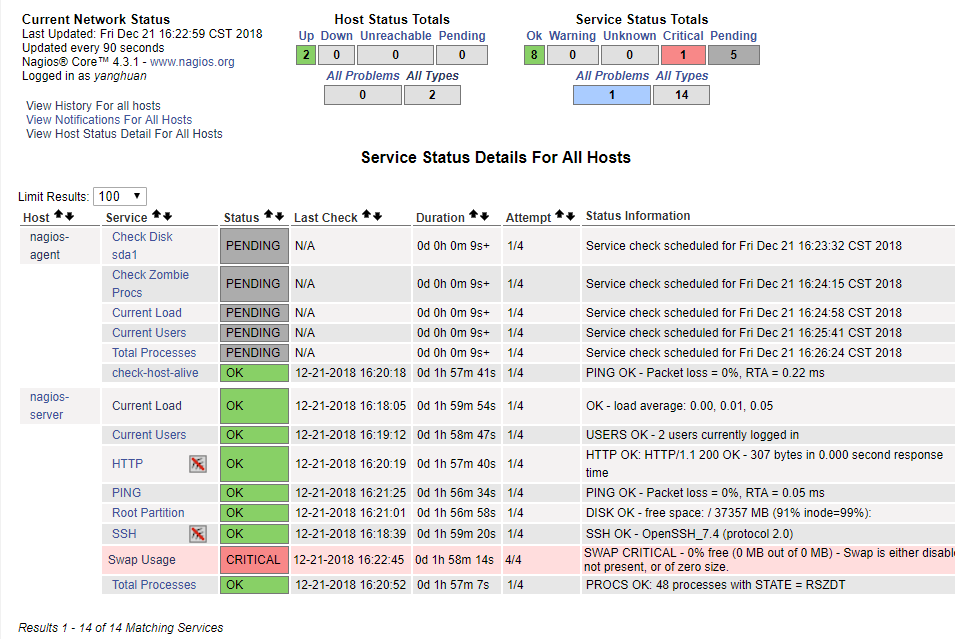
NRPE方式获取监控信息
上面已经对远程Linux 主机是否存活做了监控,而判断远程机器是否存活,我们可以使用ping 工具对其监测。还有一些远程主机服务,例如ftp、ssh、http,都是对外开放的服务,即使不用Nagios,我们也可以试的出来,随便找一台机器看能不能访问这些服务就行了。但是对于像磁盘容量,cpu负载这样的“本地信息”,Nagios只能监测自己所在的主机,而对其他的机器则显得有点无能为力。毕竟没得到被控主机的适当权限是不可能得到这些信息的。为了解决这个问题,nagios有这样一个附加组件--“NRPE”,用它就可以完成对Linux 类型主机"本地信息”的监控。
NRPE 工作原理

NRPE 总共由两部分组成:
check_nrpe 插件,位于监控主机上
NRPE daemon,运行在远程的Linux主机上(通常就是被监控机)
按照上图,整个的监控过程如下:
当Nagios 需要监控某个远程Linux 主机的服务或者资源情况时:
Nagios 会运行check_nrpe 这个插件,告诉它要检查什么;
check_nrpe 插件会连接到远程的NRPE daemon,所用的方式是SSL;
NRPE daemon 会运行相应的Nagios 插件来执行检查;
NRPE daemon 将检查的结果返回给check_nrpe 插件,插件将其递交给nagios做处理。
注意:NRPE daemon 需要Nagios 插件安装在远程的Linux主机上,否则,daemon不能做任何的监控。
在被监控机(nagios-agent)上
安装套件与依赖包
sudo yum -y install gcc gd *openssl* gd-devel perl-devel perl-CPAN
添加nagios用户
useradd nagios -s /sbin/nologing
安装nagios插件
wget https://nagios-plugins.org/download/nagios-plugins-2.1.4.tar.gz
tar -xvf nagios-plugins-2.1.4.tar.gz
sudo make
sudo make install
sudo chown nagios. /usr/local/nagios/ -R
安装nrpe
wget https://sourceforge.net/projects/nagios/files/nrpe-3.x/nrpe-3.1.0.tar.gz
tar -xvf nrpe-3.1.0.tar.gz
cd nrpe-3.1.0
./configure
sudo make all
安装check_nrpe 插件
sudo make install-plugin
安装deamon
sudo make install-daemon
安装配置文件
sudo make install-config
将nagios-server加入允许访问的主机
sudo vim /usr/local/nagios/etc/nrpe.cfg
allowed_hosts=127.0.0.1,::1 改为
allowed_hosts=127.0.0.1,::1,10.2.8.69
启nrpe服务
sudo /usr/local/nagios/bin/nrpe -d -c /usr/local/nagios/etc/nrpe.cfg
查看对应端口是否起来
sudo netstat -tunlp|grep 5666
测试nrpe是否能正常使用
/usr/local/nagios/libexec/check_nrpe -H localhost
NRPE v3.1.0-rc1
在nagios-server上
安装nrpe
wget https://sourceforge.net/projects/nagios/files/nrpe-3.x/nrpe-3.1.0.tar.gz
tar -xvf nrpe-3.1.0.tar.gz
cd nrpe-3.1.0
./configure
sudo make all
安装check_nrpe 插件
sudo make install-plugin
安装deamon
sudo make install-daemon
安装配置文件
sudo make install-config
启nrpe服务
sudo /usr/local/nagios/bin/nrpe -d -c /usr/local/nagios/etc/nrpe.cfg
查看对应端口是否起来
sudo netstat -tunlp|grep 5666
测试nrpe是否能联通本机与被监控机正常使用
/usr/local/nagios/libexec/check_nrpe -H localhost
NRPE v3.1.0-rc1
/usr/local/nagios/libexec/check_nrpe -H 10.2.8.70
NRPE v3.1.0-rc1
监控配置
在nagios-server端添加命令(加至尾行)
sudo vim /usr/local/nagios/etc/objects/commands.cfg
define command{
command_name check_nrpe
command_line $USER1$/check_nrpe -H $HOSTADDRESS$ -c $ARG1$
}
在nagios-server端添加服务(末尾添加),要注意check_disk那项要看你的盘具体叫啥名,我的vda1,对应的agent端的命令也要改
sudo vim /usr/local/nagios/etc/objects/services.cfg
define service{
use local-service
host_name nagios-agent
service_description Current Load
check_command check_nrpe!check_load
}
define service{
use local-service
host_name nagios-agent
service_description Check Disk vda1
check_command check_nrpe!check_vda1
}
define service{
use local-service
host_name nagios-agent
service_description Total Processes
check_command check_nrpe!check_total_procs
}
define service{
use local-service
host_name nagios-agent
service_description Current Users
check_command check_nrpe!check_users
}
define service{
use local-service
host_name nagios-agent
service_description Check Zombie Procs
check_command check_nrpe!check_zombie_procs
}
重启服务
sudo systemctl restart nagios
在nagios-agent端
sudo vim /usr/local/nagios/etc/nrpe.cfg #check_disk的盘名改成自己的盘名
command[check_vda1]=/usr/local/nagios/libexec/check_disk -w 20% -c 10% -p /dev/vda1
重启nrpe
sudo killall nrpe
sudo /usr/local/nagios/bin/nrpe -d -c /usr/local/nagios/etc/nrpe.cfg
查看监控项,先处于pending状态,略等待,就OK了

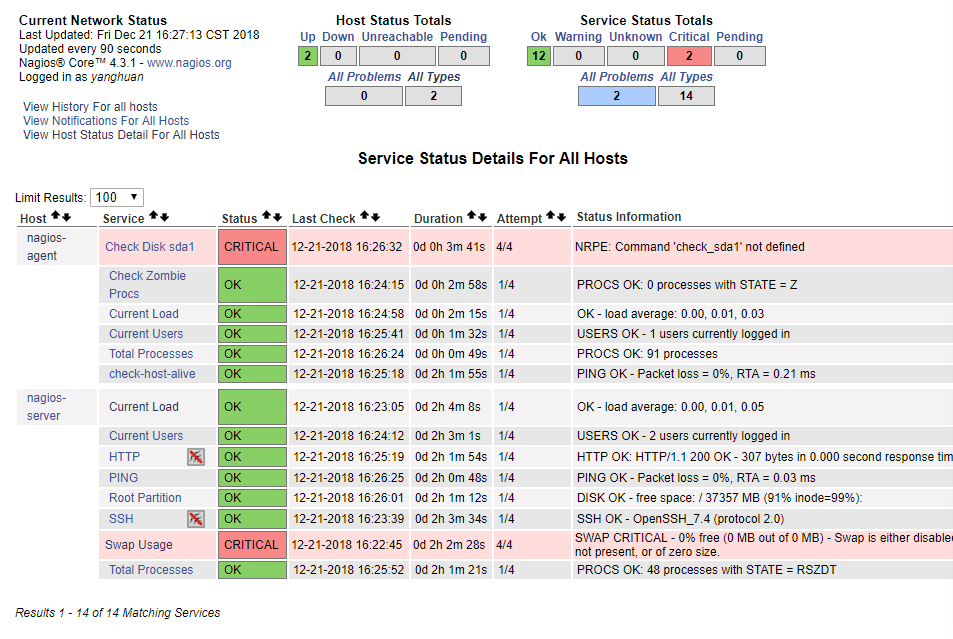
被监控机新添加check_swap 与 check_mem监控项
在nagios-agent:
在配置文件添加命令
sudo vim /usr/local/nagios/etc/nrpe.cfg
command[check_mem]=/usr/local/nagios/libexec/check_mem -w 90% -c 95%
command[check_swap]=/usr/local/nagios/libexec/check_swap -w 20% -c 10%
在 /usr/local/nagios/libexec/下查看是否存在以上两个脚本:
存在check_swap ,没有check_mem,需要添加此脚本
sudo vi /usr/local/nagios/libexec/check_mem
#! /usr/bin/perl -w
#
# $Id: check_mem.pl 8 2008-08-23 08:59:52Z rhomann $
#
# check_mem v1.7 plugin for nagios
#
# uses the output of free to find the percentage of memory used
#
# Copyright Notice: GPL
#
# History:
# v1.8 Rouven Homann - rouven.homann@cimt.de
# + added findbin patch from Duane Toler
# + added backward compatibility patch from Timour Ezeev
#
# v1.7 Ingo Lantschner - ingo AT boxbe DOT com
# + adapted for systems with no swap (avoiding divison through 0)
#
# v1.6 Cedric Temple - cedric DOT temple AT cedrictemple DOT info
# + add swap monitoring
# + if warning and critical threshold are 0, exit with OK
# + add a directive to exclude/include buffers
#
# v1.5 Rouven Homann - rouven.homann@cimt.de
# + perfomance tweak with free -mt (just one sub process started instead of 7)
# + more code cleanup
#
# v1.4 Garrett Honeycutt - gh@3gupload.com
# + Fixed PerfData output to adhere to standards and show crit/warn values
#
# v1.3 Rouven Homann - rouven.homann@cimt.de
# + Memory installed, used and free displayed in verbose mode
# + Bit Code Cleanup
#
# v1.2 Rouven Homann - rouven.homann@cimt.de
# + Bug fixed where verbose output was required (nrpe2)
# + Bug fixed where perfomance data was not displayed at verbose output
# + FindBin Module used for the nagios plugin path of the utils.pm
#
# v1.1 Rouven Homann - rouven.homann@cimt.de
# + Status Support (-c, -w)
# + Syntax Help Informations (-h)
# + Version Informations Output (-V)
# + Verbose Output (-v)
# + Better Error Code Output (as described in plugin guideline)
#
# v1.0 Garrett Honeycutt - gh@3gupload.com
# + Initial Release
#
use strict;
use FindBin;
FindBin::again();
use lib $FindBin::Bin;
use utils qw($TIMEOUT %ERRORS &print_revision &support);
use vars qw($PROGNAME $PROGVER);
use Getopt::Long;
use vars qw($opt_V $opt_h $verbose $opt_w $opt_c);
$PROGNAME = "check_mem";
$PROGVER = "1.8";
# add a directive to exclude buffers:
my $DONT_INCLUDE_BUFFERS = 0;
sub print_help ();
sub print_usage ();
Getopt::Long::Configure('bundling');
GetOptions ("V" => $opt_V, "version" => $opt_V,
"h" => $opt_h, "help" => $opt_h,
"v" => $verbose, "verbose" => $verbose,
"w=s" => $opt_w, "warning=s" => $opt_w,
"c=s" => $opt_c, "critical=s" => $opt_c);
if ($opt_V) {
print_revision($PROGNAME,'$Revision: '.$PROGVER.' $');
exit $ERRORS{'UNKNOWN'};
}
if ($opt_h) {
print_help();
exit $ERRORS{'UNKNOWN'};
}
print_usage() unless (($opt_c) && ($opt_w));
my ($mem_critical, $swap_critical);
my ($mem_warning, $swap_warning);
($mem_critical, $swap_critical) = ($1,$2) if ($opt_c =~ /([0-9]+)[%]?(?:,([0-9]+)[%]?)?/);
($mem_warning, $swap_warning) = ($1,$2) if ($opt_w =~ /([0-9]+)[%]?(?:,([0-9]+)[%]?)?/);
# Check if swap params were supplied
$swap_critical ||= 100;
$swap_warning ||= 100;
# print threshold in output message
my $mem_threshold_output = " (";
my $swap_threshold_output = " (";
if ( $mem_warning > 0 && $mem_critical > 0) {
$mem_threshold_output .= "W> $mem_warning, C> $mem_critical";
}
elsif ( $mem_warning > 0 ) {
$mem_threshold_output .= "W> $mem_warning";
}
elsif ( $mem_critical > 0 ) {
$mem_threshold_output .= "C> $mem_critical";
}
if ( $swap_warning > 0 && $swap_critical > 0) {
$swap_threshold_output .= "W> $swap_warning, C> $swap_critical";
}
elsif ( $swap_warning > 0 ) {
$swap_threshold_output .= "W> $swap_warning";
}
elsif ( $swap_critical > 0 ) {
$swap_threshold_output .= "C> $swap_critical";
}
$mem_threshold_output .= ")";
$swap_threshold_output .= ")";
my $verbose = $verbose;
my ($mem_percent, $mem_total, $mem_used, $swap_percent, $swap_total, $swap_used) = &sys_stats();
my $free_mem = $mem_total - $mem_used;
my $free_swap = $swap_total - $swap_used;
# set output message
my $output = "Memory Usage".$mem_threshold_output.": ". $mem_percent.'% <br>';
$output .= "Swap Usage".$swap_threshold_output.": ". $swap_percent.'%';
# set verbose output message
my $verbose_output = "Memory Usage:".$mem_threshold_output.": ". $mem_percent.'% '."- Total: $mem_total MB, used: $mem_used MB, free: $free_mem MB<br>";
$verbose_output .= "Swap Usage:".$swap_threshold_output.": ". $swap_percent.'% '."- Total: $swap_total MB, used: $swap_used MB, free: $free_swap MB<br>";
# set perfdata message
my $perfdata_output = "MemUsed=$mem_percent\%;$mem_warning;$mem_critical";
$perfdata_output .= " SwapUsed=$swap_percent\%;$swap_warning;$swap_critical";
# if threshold are 0, exit with OK
if ( $mem_warning == 0 ) { $mem_warning = 101 };
if ( $swap_warning == 0 ) { $swap_warning = 101 };
if ( $mem_critical == 0 ) { $mem_critical = 101 };
if ( $swap_critical == 0 ) { $swap_critical = 101 };
if ($mem_percent>$mem_critical || $swap_percent>$swap_critical) {
if ($verbose) { print "<b>CRITICAL: ".$verbose_output."</b>|".$perfdata_output."
";}
else { print "<b>CRITICAL: ".$output."</b>|".$perfdata_output."
";}
exit $ERRORS{'CRITICAL'};
} elsif ($mem_percent>$mem_warning || $swap_percent>$swap_warning) {
if ($verbose) { print "<b>WARNING: ".$verbose_output."</b>|".$perfdata_output."
";}
else { print "<b>WARNING: ".$output."</b>|".$perfdata_output."
";}
exit $ERRORS{'WARNING'};
} else {
if ($verbose) { print "OK: ".$verbose_output."|".$perfdata_output."
";}
else { print "OK: ".$output."|".$perfdata_output."
";}
exit $ERRORS{'OK'};
}
sub sys_stats {
my @memory = split(" ", `free -mt`);
my $mem_total = $memory[7];
my $mem_used;
if ( $DONT_INCLUDE_BUFFERS) { $mem_used = $memory[15]; }
else { $mem_used = $memory[8];}
my $swap_total = $memory[18];
my $swap_used = $memory[19];
my $mem_percent = ($mem_used / $mem_total) * 100;
my $swap_percent;
if ($swap_total == 0) {
$swap_percent = 0;
} else {
$swap_percent = ($swap_used / $swap_total) * 100;
}
return (sprintf("%.0f",$mem_percent),$mem_total,$mem_used, sprintf("%.0f",$swap_percent),$swap_total,$swap_used);
}
sub print_usage () {
print "Usage: $PROGNAME -w <warn> -c <crit> [-v] [-h]
";
exit $ERRORS{'UNKNOWN'} unless ($opt_h);
}
sub print_help () {
print_revision($PROGNAME,'$Revision: '.$PROGVER.' $');
print "Copyright (c) 2005 Garrett Honeycutt/Rouven Homann/Cedric Temple
";
print "
";
print_usage();
print "
";
print "-w <MemoryWarn>,<SwapWarn> = Memory and Swap usage to activate a warning message (eg: -w 90,25 ) .
";
print "-c <MemoryCrit>,<SwapCrit> = Memory and Swap usage to activate a critical message (eg: -c 95,50 ).
";
print "-v = Verbose Output.
";
print "-h = This screen.
";
support();
}
给脚本授权
sudo chmod 755 /usr/local/nagios/libexec/check_mem
重启nrpe服务:
sudo killall nrpe
sudo /usr/local/nagios/bin/nrpe -d -c /usr/local/nagios/etc/nrpe.cfg
在nagios-server
添加对应的监控项目
sudo vim /usr/local/nagios/etc/objects/services.cfg
define service{
use local-service
host_name nagios-agent
service_description Check Zombie Procs
check_command check_nrpe!check_mem
}
define service{
use local-service
host_name nagios-agent
service_description Check Zombie Procs
check_command check_nrpe!check_swap
}
重启nagios服务
sudo systemctl restart nagios
配置邮件服务
服务安装
安装相关软件包,mailx提供mail命令
sudo yum -y install mailx sendmail*
启动服务
sudo systemctl start sendmail
发送邮件测试:
sudo echo "hello test" | mail yh@xxx.com
我的邮箱能收到邮件,发送成功。
nagios邮件发送
nagios的邮件地址在/usr/local/nagios/etc/objects/contacts.cfg中有配置,当监控项达到对应的等级,nagios就会自动发邮件。
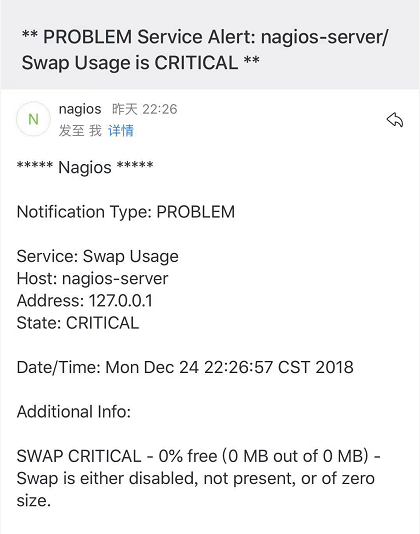
到此配置完成
错点梳理
nagios-plugins编译安装报错
-
如果你的nagios-plugins是1.4.16版本,在make时,可能会报错
./stdio.h:456:1: error: ‘gets’ undeclared here (not in a function)
解决思路:删除解压后的源码文件的指定行
sed -i '/gets is a security/d' /xx/nagios-plugins-1.4.16/gl/stdio.in.h -
编译安装nagios-plugins报错如下
check_http.c: In function ‘process_arguments’:
check_http.c:312:9: error: ‘ssl_version’ undeclared (first use in this function)
ssl_version = 0;
^
check_http.c:312:9: note: each undeclared identifier is reported only once for each function it appears in
make[2]: *** [check_http.o] Error 1
make[2]: Leaving directory '/root/nagios-plugins-1.4.16/plugins'
make[1]: *** [all-recursive] Error 1
make[1]: Leaving directory '/root/nagios-plugins-1.4.16'
make: *** [all] Error 2解决思路:
yum -y install gd openssl
启动httpd服务时报错
-
启动httpd服务时报错如下
AH00557: httpd: apr_sockaddr_info_get() failed for centos7-1/132.localdomain
AH00558: httpd: Could not reliably determine the server's fully qualified domain name, using 127.0.0.1. Set the 'ServerName' d解决思路:设定ServerName
sudo vim /usr/local/apache/conf/httpd.conf
ServerName 127.0.0.1:80
编译安装php报错
- 编译安装php报错有很多
解决思路:可能是一些套件没有安装,根据提示安装软件
nagios的web页面报错
-
都配置好后,访问nagios的web页面,http的用户登进去,就表现为下载某个文件,看不到web页面,初步分析是php解析的问题
解决思路:
php在 ./configure 这一步加上 --with-apxs2=/usr/local/apache/bin/apxs -
在nagios web界面点击services在内的多个选项出现
the requested URL /nagios/cgi-bin/status.cgi was not found on this server
解决思路:
sudo yum -y install gd-develnagios-plugins的安装顺序是否正确
httpd.conf中是否有:
ScriptAlias /nagios/cgi-bin “/usr/local/nagios/sbin”
Alias /nagios "/usr/local/nagios/share" -
web界面权限限制
在nagios web界面点击services在内的多个选项出现
It appears as though you do not have permission to view information for any of the services you requested...解决思路:
出现该问题的原因是因为目前登陆此页面的用户权限不足,默认是nagiosadmin,若登陆用户也是nagiosadmin,就不会出现此问题。
若不是,则在 /usr/local/nagios/etc/cgi.cfg中nagiosadmin授权的地方都加上登陆用户,eg:authorized_for_system_information=nagiosadmin,yh,重启nagios。
nrpe编译安装报错
-
在很多教程中,编译安装nrpe时,会有安装配置文件的一步为make install-daemon-config,但是当你执行的时候会报错
解决思路:
在一些高版本的nrpe中,make install-daemon-config 应改为 make install-config
监控项报错
-
某个监控项报错如下:
NRPE: Command 'check_zombie_procs' not defined
解决思路:
nagios-server的/usr/local/nagios/etc/objects/services.cfg中定义的check_nrpe!check_xxx相关的监控项在被监控主机的/usr/local/nagios/etc/nrpe.cfg中是否有命令定义,若没有,则加上,重启nrpe:/usr/local/nagios/bin/nrpe -d -c /usr/local/nagios/etc/nrpe.cfg -
web界面nagios server监控另一台主机的check_http,反馈:
HTTP WARNING: HTTP/1.1 403 Forbidden - 5168 bytes in 0.018 second response time
解决思路:
nagios监控HTTP时,会监控到/var/www/html/下面的index.html文件,若没有就会提示错误,touch /var/www/html/index.html即可。
邮件服务报错
-
启动 sendmail 服务可能会提示:
My unqualified host name (centosT-AutomMonitor-8069) unknown; sleeping for retry
unable to qualify my own domain name (centosT-AutomMonitor-8069) -- usin... name
发送邮件sudo echo "hello huan"|sudo mail yh@xxx.com ,邮箱收不到,日志报错dsn=5.0.0, stat=Service unavailable
wBLC3rdu014139: DSN: Service unavailable解决思路:
hostname太长,或者是格式不对,修改hostname,在centos7.5:
hostnamectl set-hostname one.com
sudo systemctl restart sendmail
再次测试,邮件发送成功